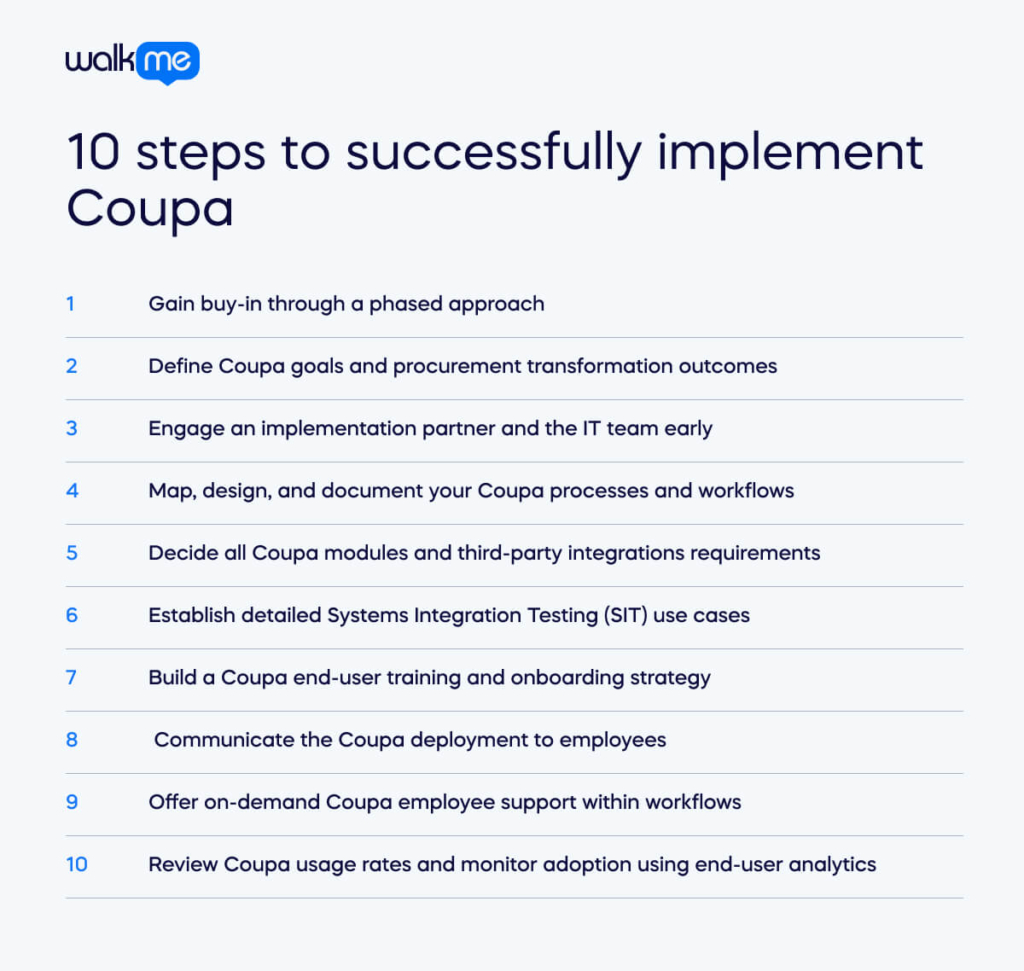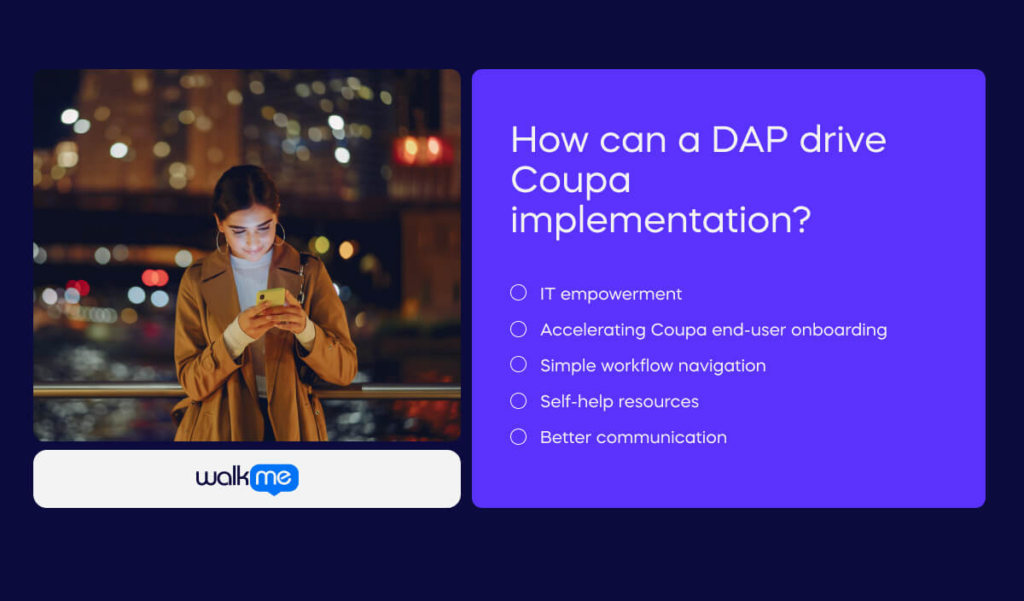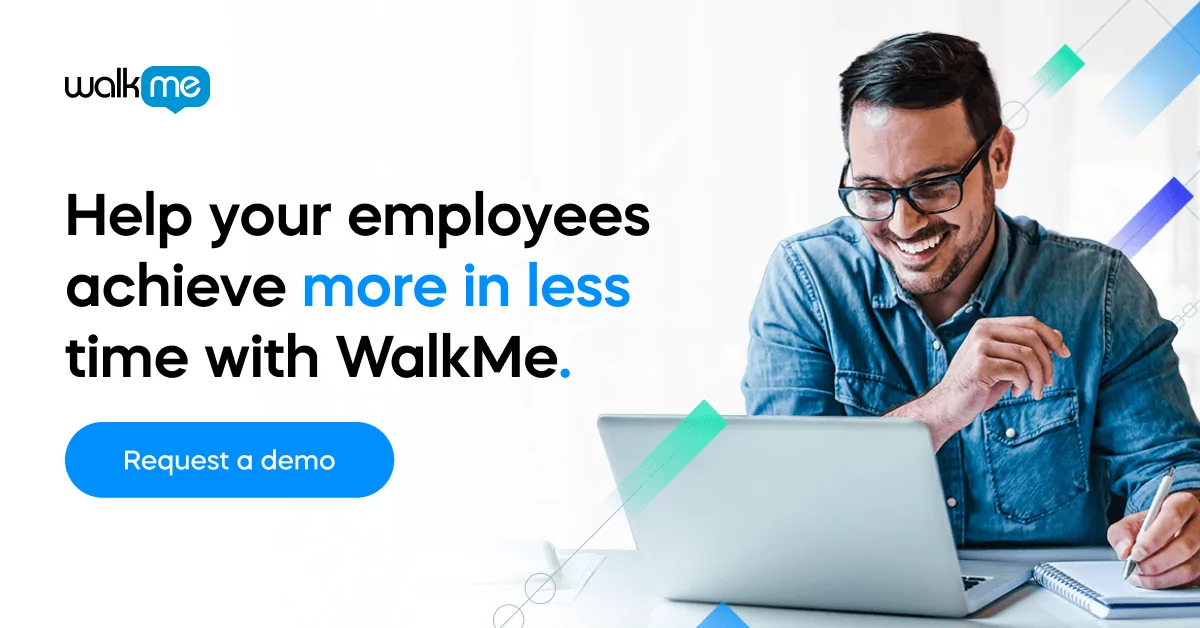Software implementation is always a pain.
However, the Coupa business expense management software presents an additional challenge. It is not an out-of-the-box tool like other ERP technologies, making a Coupa digital transformation trickier than most.
IT teams need a solid plan to prepare for Coupa. First, they must get leaders on board. Then, they build the necessary tech setup. Next, they train and support users. They keep improving Coupa to make it user-friendly, which helps everyone optimize its use.
However, implementing this software offers many rewards when you’ve achieved all that. It goes beyond traditional ERP and aids in reaching business targets.
Successful Coupa implementation is just one article away, so take the time to consider how each point is relevant to your organization. Also, remember to allocate resources to implement Coupa in advance for fast ROI and to avoid negative employee retention impact.
10 steps to successfully implement Coupa

Coupa can boost user and supplier digital adoption and safeguard your tech setup for the future. It can also strengthen your operational approach to increase efficiency and profits.
Coupa implementations are intricate. Each organization faces unique challenges based on size, industry, and digital maturity. Despite this complexity, IT teams can adopt a proven approach for successful implementation and user adoption.
Following these steps, organizations can empower themselves to attain business expense management goals and overall objectives.
1. Gain buy-in through a phased approach
Adapting to process and technological shifts varies among stakeholder groups. A phased rollout strategy is necessary to enhance adoption and preparedness for the go-live phase.
This first step entails segmenting the rollout based on modules, regions, or selected user groups. For instance, consider launching Coupa Expenses ahead of Procurement and Invoicing to acquaint users with submission and approval processes through Coupa and mobile applications.
By tailoring the rollout to each group’s specific needs and capabilities, organizations can mitigate resistance and optimize the transition to Coupa.
2. Define Coupa goals and procurement transformation outcomes
Clarify the primary objectives of your Coupa investment and the anticipated benefits and outcomes of adopting the new procurement solution. Identify the specific challenges your company encounters when implementing enterprise applications like Coupa.
Addressing these inquiries before signing the Coupa contract is crucial. They should inform your implementation strategy and remain central to IT configuration and deployment discussions.
These transformation goals will shape the approach to your Coupa implementation, ensuring alignment with your overarching objectives and enhancing the likelihood of success.
3. Engage an implementation partner and the IT team early
Internal teams juggle daily duties alongside Coupa implementation tasks. Partnering with seasoned experts offers vital assistance, strategy, and execution across the entire process. With over 500 successful Coupa implementations, CrossCountry Consulting can spearhead efforts or bolster existing teams.
Collaboration with IT and integration developers is paramount for success. Coupa seamlessly integrates with various ERPs and, in certain instances, additional systems. These systems can include inventory management, budgeting tools, banks, or tax engines.
Build diversity into your team: Get Coupa-certified administrators, Integration (MuleSoft, TIBCO, or middleware) Specialists, QA Members, product owners, Product Analysts, and Business Analysts.
By including diverse skills in your team, you ensure you have all the skills you need for every outcome and can achieve fast and sustainable ROI.
Working closely with IT ensures alignment on application infrastructure, including systems and integration methods, facilitating a cohesive solution rather than hindering progress.
4. Map, design, and document your Coupa processes and workflows
Conducting a Coupa process mapping session fosters stakeholder alignment and drives project triumph. Given organizations’ intricate existing processes, understanding, acknowledging, and envisioning them for the future with Coupa is imperative.
This step doesn’t entail a mere “lift and shift” of old processes to new technology. Rather, it involves scrutinizing current practices, redesigning them, and documenting the transformed process within Coupa’s BSM application.
The implementation partner should generate documents detailing processes, field transformations, and descriptions of current and future states. Staff can then vet these documents with key stakeholders in collaborative working sessions.
Here are instances of procurement workflows you should document:
- Expense submission and reimbursement procedures.
- Intake and purchasing processes.
- Supplier selection protocols.
- Converting sourcing awards to contracts.
- Accounts payable workflow.
- Supplier and vendor onboarding procedures.
5. Decide all Coupa modules and third-party integrations requirements
Before finalizing and deploying your Coupa workflows, ensure the platform encompasses all the necessary functionality to meet your digital procurement objectives.
Coupa offers four primary product lines: Procure, Invoice, Expense, and Pay, along with additional modules to tailor the deployment for enhanced supply chain, sourcing, inventory, contract, and vendor management.
Consider how Coupa will integrate with your enterprise software stack, including vital accounts payable and procurement tools.
This integration is particularly crucial for your ERP system, whether S/4HANA, Oracle EBS, SAP FICO, NetSuite, or others. Additionally, don’t overlook the integration with CPQ, e-signature, CLM, CRM, and other critical software.
If you already have certain ERPs, such as Oracle EBS or S4 HANA, request that the Coupa Implementation team consider the integration possibilities.
Seamless data exchange and communication between these systems and Coupa are essential for streamlining operations and maximizing efficiency in your procurement processes.
6. Establish detailed Systems Integration Testing (SIT) use cases
System Integration Testing (SIT) is a critical phase in Coupa implementation where SIT staff test different software systems together to ensure they function seamlessly.
It verifies that Coupa integrates effectively with existing systems within an organization’s technology landscape.
SIT is crucial for Coupa implementation because it ensures all integrated systems communicate correctly, data receives accurate data exchange treatment, and business processes flow smoothly without disruptions.
It helps identify potential integration issues, data discrepancies, or functionality gaps before going live, minimizing risks and ensuring a successful deployment.
To utilize SIT effectively in Coupa implementation, organizations should develop comprehensive test scenarios covering various integration points and business processes.
They should execute these tests rigorously, document any issues encountered, and resolve them promptly to guarantee a stable and reliable Coupa system upon implementation.
7. Build a Coupa end-user training and onboarding strategy
After completing your beta test, it’s time to address a frequently underestimated aspect of the implementation plan: devising a strategy for Coupa end-user onboarding and new employee software training.
Often overshadowed by technical IT projects, this step is crucial as it focuses on people and requires diverse skill sets to empower end-users effectively.
Begin by crafting tailored onboarding and training pathways for various Coupa user roles, spanning accounts payable, expense management, purchasing, vendor management, and more.
Given the diverse usage patterns within teams, providing role-based training that considers factors such as the frequency of product use, preferred workflows, and specific tasks within Coupa is essential.
This approach ensures that each user receives relevant and contextual training to optimize their utilization of Coupa functionalities.
8. Communicate the Coupa deployment to employees
As the full launch of Coupa, it’s crucial to formalize the software rollout process and communicate it to all affected end-users.
Leaders should have already informed every relevant department, and a stakeholder from each team should be part of the Coupa implementation change team.
Employ an omnichannel communication strategy to announce the Coupa rollout, incorporating:
- Organization-wide emails detailing the rationale behind the procurement change and the release date.
- In-person announcements during all-hands and department meetings.
- Enlisting people managers to relay the announcement to their teams.
- Slack notifications in relevant team channels affected by the change.
For organizations utilizing a digital adoption platform (DAP), enhance change awareness by deploying Pop-Up alerts overlaying current legacy procurement processes and ERP systems.
These alerts should provide information on the rollout timeline and include a call-to-action link to learn more about the change or access the new Coupa application if it has already been launched.
9. Offer on-demand Coupa employee support within workflows
Coupa is intricate procurement software. Organizations extensively customize it to fit their unique needs. This step is a challenge seen in Coupa’s G2 reviews. Common challenges include a steep learning curve and a less-than-intuitive user interface.
IT teams are key. They support Coupa end-users by fixing workflow issues and troubleshooting. They also offer timely help to ensure a smooth user experience.
Ignoring these concerns can cut user adoption. It will also make workflows inefficient and frustrate employees. This will ultimately lead to a failed Coupa implementation.
To solve these challenges, give Coupa end-users a digital procurement support experience that provides contextual help in their workflow.
Tools like a DAP enable on-demand, in-app support, such as Self-Help. It helps users navigate the Coupa interface.
10. Review Coupa usage rates and monitor adoption using end-user analytics
Starting your Coupa implementation is a solo task. But your IT and procurement teams must support Coupa. They must support their end-users long-term.
Use your DAP’s analytics and usage tracking. Use them to optimize Coupa. It will ensure ongoing support for end-users and maximize ROI. This action involves watching how end users engage. It is also about tracking adoption. Doing so helps us keep finding areas to improve.
By studying Coupa user behavior, IT, finance, and procurement teams gain insights. They use the insights to inform decisions. They use them to improve the platform. They refine Coupa workflows and add new in-app features.
This process is iterative. It fosters a cycle of improvement. It continuously improves Coupa workflows. It also enhances the user experience, smooths tech interactions, empowers end-users, and meets business goals related to procurement.
How can a DAP drive Coupa implementation?

A DAP enhances Coupa implementations by prioritizing end-user adoption, thus optimizing digital procurement ROI.
Whether migrating to Coupa from another vendor, modernizing procurement processes, or seeking to maximize Coupa investment, DAPs serve as dedicated partners throughout the journey.
By leveraging a Digital Adoption Platform (DAP), organizations can expedite Coupa transformation timelines and bolster ROI.
Through tailored in-app experiences and support, end-users can fully embrace Coupa, ensuring maximum supply chain efficiency and future-proofing ERP and finance processes.
A DAP simplifies complex enterprise procurement software, offering contextual in-app guidance to enhance end-user productivity and drive business outcomes.
From beta testing to long-term deployment, a DAP facilitates user-centric Coupa experiences for all end-users through:
IT empowerment
A digital adoption solution empowers IT and implementation teams. It helps them quickly create a sandbox Coupa environment, enabling beta testing with users before full deployment. The solution also conducts usability tests and facilitates hands-on user simulation testing.
Accelerating Coupa end-user onboarding
By streamlining this process, you expedite Coupa end-user onboarding during migration and the onboarding of new employees onto the procurement tool. In-app Tours, Flows, and Task Lists provide interactive training within Coupa, gamifying new user onboarding through tasks that award certifications upon checklist completion.
Simple workflow navigation
Navigating users through intricate Coupa procurement workflows is simplified with Flows, supplemented by Smart Tips that offer critical knowledge and highlight key moments in the user experience (UX). This reinforcement learning operates seamlessly in the background of digital procurement and supply chain processes, enhancing user proficiency.
Self-help resources
DAP support extends to Coupa end-users through on-demand, self-help resources via Self Help, fostering self-sufficiency, enhancing knowledge transfer, and reducing IT workload by deflecting procurement-related IT issues.
This “user assistant” module sits on top of the Coupa UI. It integrates many knowledge sources, including in-app guided Flows, third-party Coupa resources, SOPs, company policies, compliance regulations, video embeds, and more.
Better communication
For effective communication, Pop-Ups overlay Coupa deployments. They convey new Coupa process changes, app updates, feature launches, deadlines, and HR announcements. Additionally, in-app Surveys facilitate the collection of end-user feedback.
Consider all the reasons above for utilizing a DAP to drive your Coupa implementation. Achieve faster ROI and reduce employee frustration.
Allocate resources for Coupa implementation in advance
Allocating resources in advance is crucial for implementing Coupa. The reason is that it is not an out-of-the-box tool.
Coupa requires tailored setups. It needs integrations and user training. These requirements set it apart from standard procurement software.
First, assess your requirements. Identify specific needs. These include customization, integration, and training.
Secondly, plan your budget. Allocate funds for software licenses, implementation services, and potential contingencies.
Finally, allocate your resources. Assign dedicated personnel, such as project managers and IT support. Also, set aside time for training and implementation tasks.
Good planning ensures enough time and money. These are for customization, data movement, and handling surprises.
This approach boosts efficiency. It cuts disruptions. It ensures a smooth switch to Coupa’s strong procurement solution. This action leads to fast ROI. It also cuts employee frustration. It eases procurement.


